Crossing Artistic Boundaries in Cuba

Berklee's Interarts Ensemble with Chucho Valdés
Photo by Maria Magdalena Campos-Pons

Katie Bilinski and John Hull work with Miguel Parera at the Laboratorio Nacional de Música Electroacústica.
Photo by Brenda Pike

The Cuban students were well prepared to collaborate with the Berklee students thanks to professors Sigried Macias (above) and Juan Piñera.
Photo by Brenda Pike

Katie Bilinski and John Hull perform at the Instituto Superior de Arte.
Photo by Brenda Pike

ISA dance students perform to music by Berklee students.
Photo by Brenda Pike

Berklee's Interarts Ensemble and the ISA students take a moment together before their concert.
Photo by Maria Magdalena Campos-Pons

Juan Piñera (right) and Neil Leonard (center) introduce the concert at the Museo de Bellas Artes with the help of translator Melba Nuñez.
Photo by Brenda Pike

The students perform their "mosaic" at the museum.
Photo by Brenda Pike

The musicians, dancers, and professors take a bow after the concert.
Photo by Brenda Pike

Hansel Santos (leftmost drummer) sits in during a bembé at the home of the Hermanos Arango.
Photo by Brenda Pike

The students dance at the bembé.
Photo by Maria Magdalena Campos-Pons
The rigor of Berklee can sometimes lead to a sort of tunnel vision for students focused completely on their own instrument or major. But when Berklee's Interarts Ensemble, under the direction of Electronic Production and Design professor Neil Leonard, went to Cuba this month, they saw firsthand how strongly connected different types of music—and art—could be.
"Cuban folkloric culture is by definition interdisciplinary art," says Leonard. "There's dance, there's recitation, there's music, there's food, there's clothing, there's installation. . . . The bembé [a Yoruban religious ceremony that incorporates drumming, singing, dancing, and more] is interdisciplinary art in one of its really ancient forms."
The four members of the ensemble—students John Hull, Katie Bilinski, and Julia Easterlin, and alumnus Enrico de Trizio—make a far more modern form of interdisciplinary art, with laptops, iPads, looping pedals, and mixing boards as their instruments. The assignment of this first Berklee student group to go to Cuba was to collaborate with students at the Instituto Superior de Arte (ISA) and Laboratorio Nacional de Música Electroacústica to create pieces that drew on their surroundings and would be performed at ISA and the Museo de Bellas Artes.
The results were two shows that incorporated not only diverse cultural influences, but also a variety of instruments and even sensory inputs, as well. Videos showed visualizations of the music, modern dancers interpreted compositions, Cuban poetry stitched together pieces by different composers, and laptops shared the stage with traditional batá drummers.
Electroacoustic may not be the first thing that comes to mind when one thinks of Cuban music—due in no small part to the current limited access to technology—but students at the electroacoustic laboratory are using the resources they have to break expectations.
"They have a distinct aesthetic that's all their own," says Easterlin. "I thought that it would be very groove-based, but these electronic musicians are working on stuff that's really avant garde."
The ensemble was also able to experience more traditional Cuban music by observing a bembé at the home of the Hermanos Arango in the Guanabacoa district of Havana.
"I was most impressed by the lack of inhibitions they had when it came to the arts. The passion was palpable," says Bilinski. "Everyone was a singer. Everyone was a dancer. There was no division between performers and audience."
The group even got to visit with multiple Grammy–winning pianist Chucho Valdés in his home for an impromptu master class of sorts, in which the students performed a composition for him and he reciprocated with a song from his latest CD.
"Silencio" by Enrico de Trizio and Julia Easterlin
For Leonard, this trip was 25 years in the making. He first visited Cuba in 1986, developing a relationship with electroacoustic pioneer Juan Blanco, founder of the laboratory. The experience not only enriched his music, but also his life: after he returned to the U.S. he met Cuban visual artist Maria Magdalena Campos-Pons (then a student at Mass Art). They've been married for two decades now, together founding GASP Gallery in Brookline, where they present work in all genres.
The Interarts Ensemble has created a number of hybrid works in the past few months, both locally and internationally. They've created an audio/video performance with students of Boston's School of the Museum of Fine Arts that was broadcast live to the Videoformes Festival in France, presented a piece created using solar wind data at the International Conference for Auditory Display in Washington, D.C. and the MusicAcoustic conference in Beijing, and did a joint residency at the medieval Castello Malaspina in Italy that paired them with artists from Folkwang Hochschule to create real-time computer animation. "The Cuban concerts are another example of how far we can go in terms of interdisciplinary work," says Leonard.
"Both the U.S. and Cuban participants were deeply enthusiastic to see this cross-cultural dialogue actually bear fruit," he says. "It wasn't just a class, it was a real bridge."
The ensemble's visit to Cuba was just the first step across that bridge. Leonard is already planning on bringing groups of students to the island twice a year and widening the scope of the collaboration. "One of the things that I'd like to see personally is more collaboration between young choreographers and our musicians, a collaboration between our composers and theater," he says.
The members of the Interarts Ensemble hope that the work they've done in Cuba will help to encourage Berklee students to look at music in a more holistic way.
"Especially in Western culture, we make music this very isolated thing, when really I think it should be a part of your natural existence," says Easterlin. "Why would we not also be dancing and also painting and also doing whatever else we feel like doing? I'm not just a musician; I'm a creative human being. These are all the different things that I like to do, and music is one of them."
